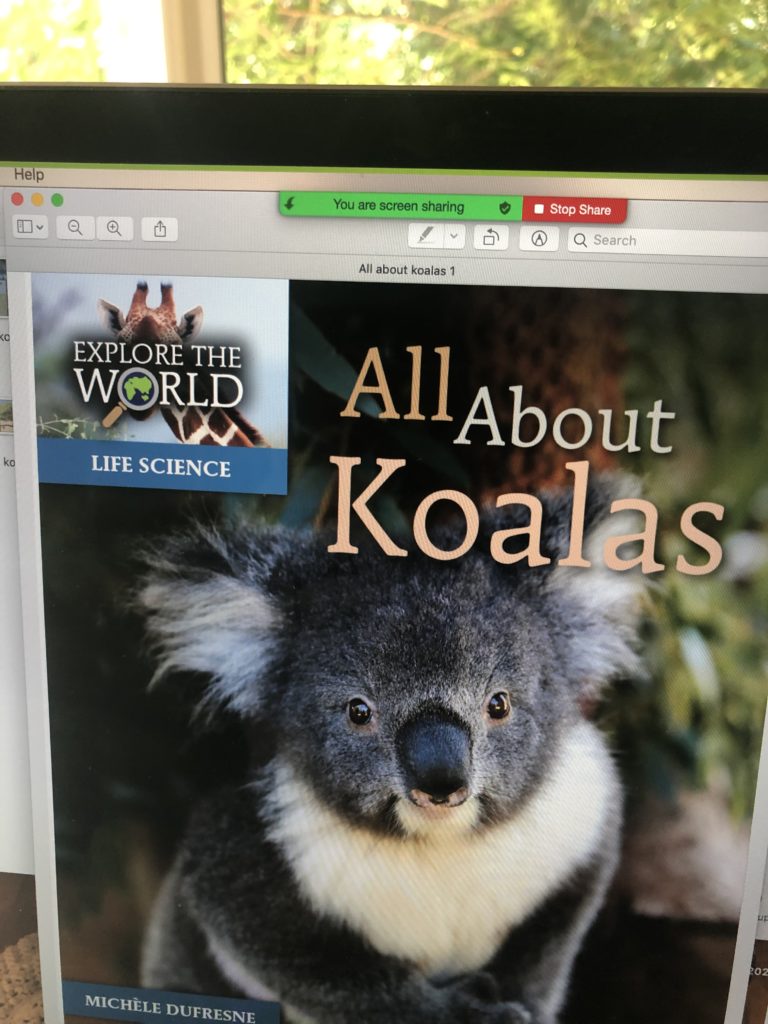
I’ve been lucky to teach small group guided reading virtually several times in the last month with some amazing think partners. We’ve learned a lot. Here’s a few take-aways to start.
If you see students in-person this fall, start teaching distance learning routines right away.
You may start the year together and then a case or wave of COVID-19 may shut local schools down or you may be teaching via a hybrid model. These are good reasons to start having conversations about what the classroom learning routines you are teaching students look like “when you’re at home” –how they are different and similar. Then PRACTICE – engage students in on-line learning while they are in the room with you.
If you do not start the year in-person with students, then devote synchronous lessons to learning the routines. With kindergarten and even some first and second grade students, you may need to meet with individuals to help establish routines.
Find a platform where you can listen to students read without everyone else listening.
For me, it’s not guided reading if I cannot confer with individuals privately at their point of need. The research shows students will not take the risks they need to take if their peers are listening. Please do not resort to round robin reading or listening to a student read while the other students in the group can hear (even if they are supposed to be doing their own reading) or shared reading (unless they are PreA stage readers). Find a way. I taught several lessons on Webex; when I needed to read with an individual child, I sent the others to the waiting room to read on their own–never for very long (just a few minutes). When I finished with one student, I sent him to the waiting room and pulled another student back into the meeting room with me. I limited conferring to meeting with one or two students before regrouping. (This can be done on Zoom as well.) I haven’t tried this, but you might be able to send students into a “meeting room” by themselves as well once the folks at Microsoft TEAMS add that feature. BTW – students need access to their own copy of the book. Their access, when reading on their own, shouldn’t be limited to the copy you screen share with them 😉 (more on this soon).
With kindergarten, my colleagues and I found that a 1:1 teacher-student ratio is best. Then the platform you use is not an issue. (We paired TEAMS with ClassKick — more on this soon, too!!!) This might change if students get to know the routines. Instead of a longer lesson, we just met with each kinder student for 15 minutes. Even 10 minutes might be better for some students versus meeting with a group for 20 to 30 minutes. Still thinking about how this will work in the fall with a full class ;).
Less is more.
Students only have so much attention they can give. I planned lessons fully and then I watched my timer. I kept the lessons to 15 or 20 minutes (depending on the group and age). WHEN THE TIMER GOT TO 20, WE WERE DONE. For the next lesson, I just picked up where we left off. Sometimes a three day plan took five days. This is okay because learning was still happening!!!
Take it easy on yourself.
The more lessons I taught, the more I learned to slow down. There are a lot of factors at play that we are not in control of– a student getting into the right program on-line, crying babies in the background, the child being fidgety or lethargic, poor Internet connections. I’ve found that steady, consistent, and cheerful 😉 make for the best approach. And over the course of multiple lessons, the students started to engage more efficiently and make progress.
Remember your purpose.
This may be a no-brainer, but in the rush to move to distance learning, it can be easy to lose sight of our purpose. My purpose during reading instruction is to create a safe space for students to take risks and develop a sense of agency and identity as problem-solvers, as learners. Remembering my purpose has been my guide in making decisions about “how” this will happen with distance learning. It’s also helpful to think about what we know to be true about how children best learn or core principles for learning which can also serve as a guide. For example, we know that children learn when they can engage in individual reading conferences as part of a lesson, conferences where the teacher affirms, assesses, and then teaches at the point of need. This principle (which also serves my purpose) has driven my choice of platforms.
THERE’S SO MUCH MORE TO SAY. I have thoughts about parents as partners (not enablers), starting each lesson with…, routines unique to distance learning, how to help students access books, ETC ETC. I’m planning to write short blog entries with tidbits over the next several weeks. Let me know your thoughts, feedback or if you have any questions. AND if you are teaching virtually and would like to partner with me, let me know!!! I’m up for the challenge.
Finally, a BIG THANK YOU. I feel so fortunate to have had the opportunity to engage in professional inquiry with some amazing educators (Stacey, Lisa, Carol, Jeanne, Rachel, Zoila, Katie, Chelsea, Esther, Melissa, Kelsey)–who observed, taught, reflected, and stretched with me.
Hope this helps.
Sunday
